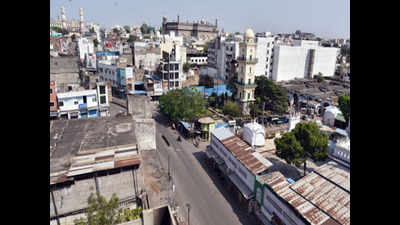- News
- City News
- Hyderabad News
- No impact of lockdown on Hyderabad’s air quality, ‘good’ tag eludes city
Trending
This story is from April 5, 2020
No impact of lockdown on Hyderabad’s air quality, ‘good’ tag eludes city

<p>Despite lesser vehicular movement, official data has shown that Hyderabad’s air quality index (AQI) continues to remain moderate — only marginally lower than on usual days.<br></p>
HYDERABAD: Unlike Delhi and other cities in India, the lockdown doesn’t seem to have made much of an impact on Hyderabad’s pollution levels. Despite lesser vehicular movement, official data has shown that city’s air quality index (AQI) continues to remain moderate — only marginally lower than on usual days.
While the AQI — largely based on PM2.5 and PM10 levels — saw a dip immediately after the janata curfew was announced on March 22 and hit a low of 59 on March 26, it started rising soon after.It touched 98 on April 2, even as Delhi recorded an AQI of 69. These figures were recorded by the Central Pollution Control Board (CPCB) that calculates AQI and usually releases the data at 4 pm every day for a 24-hour period.

In its report ‘Impact of Janata curfew & lockdown on air quality’, CPCB, however, monitored AQI level at 7 am (a deviation from standard 4 pm monitoring). It showed that Hyderabad’s air quality stood at 107 on March 22 but dropped to 67 the next day. But, on none of the days after the lockdown, did Hyderabad make it to the ‘good’ category. It stayed in the ‘moderate’ zone — which is anything between 51and 100 — where “sensitive people can face minor breathing discomfort.”
Confirming Rao’s analysis, Mahesh Palawat, chief meteorologist at Skymet weather services, said: “Clouds over parts of Telangana and higher levels of humidity may have resulted in local pollutants mixing with water vapour leading to current AQI levels.” He added that the cloud cover was a result of a trough extending from Karnataka to Telangana and another from north Bihar to south Odisha. “The next 24 hours will see isolated light rain in Telangana resulting in lesser dissipation of pollutants,” he said.
While the AQI — largely based on PM2.5 and PM10 levels — saw a dip immediately after the janata curfew was announced on March 22 and hit a low of 59 on March 26, it started rising soon after.It touched 98 on April 2, even as Delhi recorded an AQI of 69. These figures were recorded by the Central Pollution Control Board (CPCB) that calculates AQI and usually releases the data at 4 pm every day for a 24-hour period.

In its report ‘Impact of Janata curfew & lockdown on air quality’, CPCB, however, monitored AQI level at 7 am (a deviation from standard 4 pm monitoring). It showed that Hyderabad’s air quality stood at 107 on March 22 but dropped to 67 the next day. But, on none of the days after the lockdown, did Hyderabad make it to the ‘good’ category. It stayed in the ‘moderate’ zone — which is anything between 51and 100 — where “sensitive people can face minor breathing discomfort.”
Even as the board’s report indicated dust and construction activities, transport sector and industry as major sources of PM2.5, experts said even weather plays a role in a city’s AQI. “In cities, the movement of essential services, volunteers and others may play a small role in AQI levels rising. But, gloomy weather conditions may also be playing a spoilsport,” said Subba Rao, a former member on a panel for industries in the Telangana State Pollution Control Board.
Confirming Rao’s analysis, Mahesh Palawat, chief meteorologist at Skymet weather services, said: “Clouds over parts of Telangana and higher levels of humidity may have resulted in local pollutants mixing with water vapour leading to current AQI levels.” He added that the cloud cover was a result of a trough extending from Karnataka to Telangana and another from north Bihar to south Odisha. “The next 24 hours will see isolated light rain in Telangana resulting in lesser dissipation of pollutants,” he said.
End of Article
FOLLOW US ON SOCIAL MEDIA










